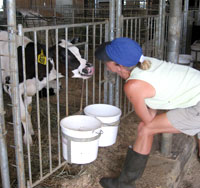Planning Strategies
"[In traditional education]…the school environment of desks, blackboards, a small school yard was supposed to suffice… There was no demand that the teacher should become intimately acquainted with the conditions of the local community, physical, historical, economic, occupational etc. in order to utilize them as educational resources."
John Dewey, 1938, p. 40
It is a challenge to learn outside of the classroom. One of the ways that we (CBEI) help teachers to become “intimately acquainted with ….the local community,” as John Dewey advised, is to enable them to experience learning in these places first-hand.

Through a variety of field experiences throughout the Basin—sites that address different topics and issues—we invite teachers to consider ways that students can learn in actual places ... on a farm, in a river. We refer to these places to learn as "sites of engagement."
By experiencing these places and having time to reflect on how learning on-site might enhance their students’ understanding of key content and BIG IDEAS—we give teachers tools and time to develop strategies to plan meaningful learning outside of the classroom that align with their academic purpose.
For example, we visited the International Paper plant in Ticonderoga, New York. As we stood in the lot outside the plant, huge trucks laden with mammoth trees arrived. After touring the factory, we each left with a ream of paper. Tree to paper. We saw the whole process. Shouldn’t kids know the origin of things like paper and which raw materials are locally sourced and how?
Our trips to farms and meetings with farmers are similar. “I have never been on a farm” says at least one teacher every year. In exploring the many places and happenings in a watershed—we are meeting up with some of the basic systems of our world that students should become more closely acquainted with.
Gardens and watersheds proved to be particularly effective settings where children could experience living systems and basic concepts of ecological literacy firsthand—the flow of energy from the sun to plants and animals, planetary cycles of water and weather, the web of relations embodied in every bite.
Zenobia Barlow and Michael K. Stone
LIVING SYSTEMS AND LEADERSHIP:
CULTIVATING CONDITIONS FOR INSTITUTIONAL CHANGE

By exploring these sites themselves, teachers are able to better imagine new ways to take their students outside.
Field Experiences are fun and exhilarating, but they take a lot of work to plan. It is helpful for teachers to consider these three questions:
POP Strategy from This Lake Alive! for planning how to learn in the field:
- What do my students need to know before they go? (PRE)
- What will my students do on site? (ON-SITE)
- What will they do with the knowledge after the field experience? (POST)

